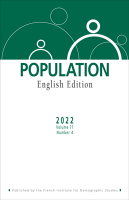
Population 2022, n 4
2022
Recent Demographic Trends in France. Ongoing Impact of the COVID -19 Pandemic at Both Regional and National Levels
Didier Breton, Nicolas Belliot, Magali Barbieri, Hippolyte d’Albis, Magali Mazuy
Differences in Intimate Partner Violence Reported by Lesbian, Bisexual, and Heterosexual Women
Tania Lejbowicz
Social Networks and Family Change in Japan Revisited
Martin Piotrowski, Ronald R. Rindfuss , Emi Tamaki, Minja Kim Choe, Noriko O. Tsuya, Larry Bumpass
Social Isolation in a Solidarity-Based Society: The Example of the Sereer Siin in Senegal
Véronique Deslauriers, Simona Bignami, Valérie Delaunay, John Sandberg
Recent Demographic Trends in France. Ongoing Impact of the COVID -19 Pandemic at Both Regional and National Levels
Didier Breton, Nicolas Belliot, Magali Barbieri, Hippolyte d’Albis, Magali Mazuy
On 1 January 2022, the population of France was 67.8 million, 187,000 more than on 1 January 2021. Numbers of births, abortions, and marriages in 2021 were higher than in 2020 but did not return to the levels observed before the COVID-19 pandemic (2019). Mortality followed a similar pattern, with an improvement in 2021, but not a return to pre-crisis levels. In 2021, France was one of nine countries in EU-27 with positive natural population increase, although net migration made a larger contribution to demographic growth. The French population is still growing, therefore, but more slowly than before the pandemic. In 2020, admissions of third-country nationals with a residence permit fell sharply due to the health crisis. Admissions for employment reasons decreased most markedly. Inflows were concentrated in the Paris region (Île-de-France). In 2021, the
total fertility rate increased very slightly (1.83 children per woman) due mainly to an increase in rates at ages 30–39, with an age profile that varies across regions. The number of abortions remained stable between 2020 and 2021, but the share of medical abortions is increasing each year (77% in 2021), above all those managed in non-hospital settings. There are large geographical disparities, however, due to inequalities in care provision
at local level. The upturn in marriages in 2021 only partially made up for those that could not be celebrated in 2020. PACS unions outnumbered marriages for the first time in 2020. Marriages are more frequent in eastern France, and PACS civil unions along the Atlantic coast and in the south-west. While lower than in 2020, the number of deaths remained high in 2021. Life expectancy in 2021 was still 4.6 months lower than in 2019 for
men, and 1.4 months lower for women. Estimated excess mortality was 6.3% in 2021, after reaching 7.5% in 2020. The most affected regions are not necessarily those where mortality was initially high.
Differences in Intimate Partner Violence Reported by Lesbian, Bisexual, and Heterosexual Women
Tania Lejbowicz
This article examines intimate partner violence inflicted against women by those women’s sexual identification and the violent partner’s sex. Drawing on the Violences et rapports de genre survey, the article shows that the acts of violence women in same-sex couples are subjected to are less intense and involve less physical or bodily violence than in different-sex couples, wherein female partners are exposed to more severe acts involving more sexual violence. In male–female couples, victim-reported acts of violence differ by victim’s self-reported sexual identification: heterosexual women report having been subjected to more physical violence than lesbian or bisexual women; the latter categories report more sexual violence. This article recalls the importance of having detailed data on couple and sexual trajectories for effective apprehension of report differences. It also highlights the need to investigate variability in the experience and perception of violence against women by couple type (same- or different-sex) and the sexual identification (lesbian, bisexual, heterosexual) of the woman reporting the acts of violence.
Social Networks and Family Change in Japan Revisited
Martin Piotrowski, Ronald R. Rindfuss , Emi Tamaki, Minja Kim Choe, Noriko O. Tsuya, Larry Bumpass
Using data from the 2000 and 2009 National Surveys of Family and Economic Conditions in Japan, we examine the relationship between knowing someone engaged in ‘innovative’ family behaviors, such as cohabitation, unmarried sex, and use of childcare by working mothers, and the attitudes toward such behaviors. We extend existing research on this topic in two ways: (a) by adding a longitudinal component to estimate a fixed-effects
model that controls for the influence of unmeasured, time-invariant factors likely to be related to both knowing and attitudes; and (b) by focusing more explicitly on gender differences. We find that net of unmeasured timeinvariant characteristics, changes in attitudes toward innovative family behaviors are associated with changes in knowing people engaged in them in parallel or related domains. Changes in attitudes toward marriage as
necessary for men’s and women’s full lives are only related to changes in knowing for women.
Social Isolation in a Solidarity-Based Society: The Example of the Sereer Siin in Senegal
Véronique Deslauriers, Simona Bignami, Valérie Delaunay, John Sandberg
Although sub-Saharan Africa is undergoing major social changes, including those in the support role played by families, the phenomenon of social isolation has been little studied. This article sets out to identify a theoretical framework for studying social isolation in the solidarity-based societies of sub-Saharan Africa and to describe how such isolation manifests among the Sereer Siin in Senegal. The analysis is based on 52 interviews
conducted as part of a survey on social networks by the Niakhar Social Networks and Health Project. These data suggest that isolation happens through the inability to maintain membership of the informal social insurance system. They further suggest that migration (men migrating for work, women for marriage) is an explanatory factor for social isolation when it occurs in such situations as family conflict and impoverishment.

